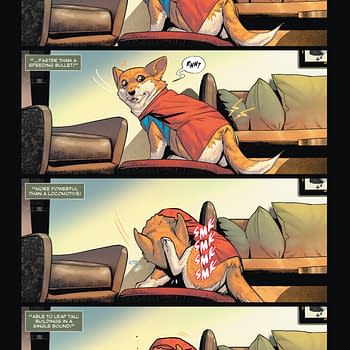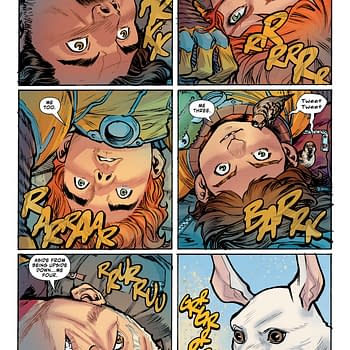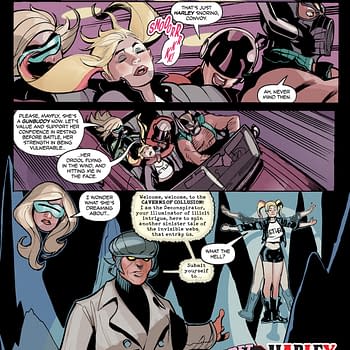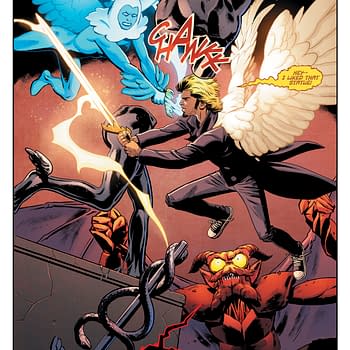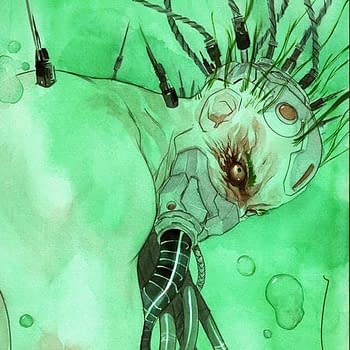Posted in: Comics | Tagged: anti-hero, black holes, Comics, entertainment, frazer irving, grant morrison, Legendary Entertainment, The Annihilator
5 Notes On Annihilator For The Curious-Minded
Annihilator #1 comes out today from Legendary Entertainment, written by Grant Morrison (see his previous interview at Bleeding Cool here) and illustrated by Frazer Irving. It's a "witchy" tale of a fair amount of complexity and considering its complexity is not something you'll be able to do at a first reading. The visuals of this strange world and the fates of the two main characters: Ray Spass and Max Nomax will thoroughly distract you from that. But after you've had a read, here are some basic notes to get you started thinking:
1.The Annihilator
I.F. Mirabel, a French Physicist, poetically titles a chapter heading of his paper on The Annihilator, "The Sepulchral Silence of the Hypothetical Super-Massive Black Hole". If the latter part of that phrase sounds familiar from a Muse song, the band referring to the same posited phenomenon. Mirabel describes two decades of research prompted by the observation of physicists based on gamma radiation presence that may indicate a source capable of producing positrons to the degree of a black hole of "several million solar masses residing at the dynamic center of the galaxy". While I am no physicist, the rest of the paper seems to argue that the great black hole known as The Annihilator is, in fact, not quite in the center but slightly off-center. Who knew? Find the rest of that document here.
2. The Byronic Hero
To what extent is Max Nomax "evil" or as evil as he wants us to believe? Well he's the ultimate thief from every mythology, really, as we'll see developing in the comic, and he wants to turn the natural order of the universe upside down. But he's also the anti-hero of all mythology, and most shaped by our modern take on the "Byronic Hero", according to Morrison.
And here's our definition of "Byronic Hero":
Byronic heroes tend to be characterized as being intelligent, cunning, ruthless. arrogant, depressive, prone to violence, self-aware, emotionally and intellectually tortured, traumatized, highly emotional, manipulative, self-serving, spiritually doubtful, often reckless or suicidal, prone to bursts of anger, as well as decidedly prone to substance abuse, dedicated to perusing matters of justice over matters of legality, self-destructive impulses, and seductive and sexually appealing.
Byronic Heroes tend to feel loyalty, seemingly, only to themselves and their core beliefs and values. While they often act on behalf of greater goods, they will rarely acknowledge doing such.
Find out more about that here.
3. Space
One of our duo of central characters is named Ray Spass, pronounced "Space". That, of course, is very resonant. He's Ray like "light", he says in the hospital, and also a seeming opposite of sorts, Space.
Space is technically defined as:
I like the "unoccupied" definition myself. He's free, empty, and his own black hole, like the sink-hole in his garden that's a "door" to hell.
4. Occultism in Los Angeles
This is a big subject. Los Angeles is not exactly your typical gothic location, given its immense amount of sunlight throughout the year, but you know, Lucifer was a bright guy too. Several occult connections are mentioned in this first issue, and mythologized around the house Ray Spass has taken over to write his screenplay. But occult stuff in Los Angeles goes way back, and this place Morrison describes as "witchy" makes for an excellent location to conjure a super-massive black-souled presence like Max Nomax. Find out more about the early roots of occultism in Los Angeles from the Disinformation site here.
5. Crepuscular
Frazer Irving's art on this book is magnificent already, and we've only seen the first issue. I really hadn't braced myself fully for the physicality of his settings and characters and his use of forced perspective to make you feel things are bending under the pull of a black hole in just about every scene. The light of Los Angeles was something he was particularly attempting to capture, and the way in which certain shades of bright light can be both eerie and sinister. A fancy word for evening light with organic, decaying qualities is "crepuscular".

Here's our definition of "crepuscular rays" that occur at twilight:
Crepuscular rays occur when objects such as mountain peaks or clouds partially shadow the sun's rays. The name crepuscular means "relating to twilight" and these rays are observed at sunrise and sunset. Crepuscular rays appear to diverge outward from the setting sun, and are visible only when the atmosphere contains enough haze or dust particles so that sunlight in unshadowed areas can be scattered toward the observer. The light rays are actually parallel, but appear to converge to the sun due to "perspective", the same visual effect that makes parallel railroad tracks appear to converge in the distance. Crepuscular rays are often red or yellow in appearance because blue light from the sun is selectively scattered out of the beam by air molecules.
Here's a meteorological site for that one.















